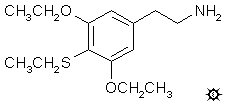
#179 4-T-TRIS
4-THIOTRESCALINE; 4-THIOTRISESCALINE; 3,5-DIETHOXY-4-ETHYLTHIOPHENETHYLAMINE
|
| [3D .mol structure] |
To a stirred solution of 17.3 g of 1,3-diethoxy-2-ethylthiobenzene in 175 mL CH2Cl2 there was added 11.8 g elemental bromine dissolved in 100 mL CH2Cl2. There was an immediate loss of color, and the obvious evolution of HBr gas. After stirring at ambient temperature for 1 h, the dark solution was added to 150 mL H2O containing 1 g of sodium dithionite. Shaking immediately discharged the residual bromine color, and the organic phase was separated, The aqueous phase was extracted once with 75 mL CH2Cl2, the pooled extracts washed first with H2O, and then with saturated brine. Removal of the solvent under vacuum provided 34.2 g of a pale yellow oil with several globs of H2O that were mechanically removed. This wet product was distilled at 105-125 °C at 0.35 mm/Hg to yield 4-bromo-1,3-diethoxy-2-ethylthiobenzene as an off-white oil weighing 21.6 g. It could not be crystallized. Anal. (C12H17BrO2S) C,H.
To a solution of 20.2 g diisopropylamine in 200 mL anhydrous THF that had been cooled to -10 °C under a He atmosphere with an external ice/MeOH bath, there was added 125 mL of a 1.6 M solution of butyllithium in hexane. There was then added, in sequence, 5.1 mL of dry CH3CN followed by the dropwise addition of 15.3 g 4-bromo-1,3-diethoxy-2-ethylthiobenzene diluted with a little anhydrous THF. There was only a modest color development. Analysis by thin-layer chromatography showed that the reaction components were largely starting bromide and only a little product nitrile. An additional 2.5 mL dry CH3CN was added, followed immediately by a solution of lithium diisopropylamide prepared separately from 14 mL isopropylamine in 50 mL hexane treated with 60 mL butyllithium solution. There was an immediate darkening of color. After 15 min stirring, the bromo starting material was gone, by TLC analysis. The reaction mixture was then poured into 1 L dilute H2SO4. The organic phase was separated and the aqueous fraction extracted with 2x100 mL CH2Cl2. These extracts were pooled, washed with H2O, dried with anhydrous K2CO3, and the solvent was removed under vacuum. The residue was distilled at 0.3 mm/Hg yielding two fractions. The first fraction boiled at 124-145 °C and gave an amber liquid weighing 2.4 g. It was largely starting bromo compound with a little nitrile, and was not processed further. The second fraction distilled at 140-190 °C and weighed 6.2 g. Although this was largely product nitrile, it was quite complex by chromatographic analysis. It was redistil-led at 0.3 mm/Hg and several fractions taken. The material collected at 145-165 °C weighed 3.2 g and was approximately 80% 3,5-diethoxy-4-ethylthiophenylacetonitrile by TLC assay. This was used in the subsequent reduction. The earlier fraction in this second distillation (130-145 °C) weighed 2.1 g but contained only 50% product nitrile by TLC analysis, and was discarded.
A solution of LAH in anhydrous THF under N2 (20 mL of a 1.0 M solution) was cooled to 0 °C and vigorously stirred. There was added, dropwise, 0.53 mL 100% H2SO4, followed by 3.0 g 3,5-diethoxy-4-ethylthiophenylacetonitrile diluted with a little anhydrous THF. The reaction mixture was stirred at room temperature for 1 h, and then at reflux on the steam bath for an additional 0.5 h. After cooling back to room temperature, there was added IPA to destroy the excess hydride and 10% NaOH to bring the reaction to a basic pH and convert the aluminum oxide to a loose, white, filterable consistency. This was removed by filtration, and washed first with THF followed by IPA. The combined filtrate and washes were stripped of solvent under vacuum, the residue added to 1 L dilute H2SO4. This was washed with 2x75 mL CH2Cl2, made basic with 25% NaOH, and extracted with 3x100 mL CH2Cl2. After combining, the solvent was removed under vacuum providing a residue that was distilled. A fraction boiling at 135-150 °C at 0.3 mm/Hg weighed 1.2 g and was a light yellow oil. This was dissolved in 20 mL of IPA, and neutralized with 17 drops of concentrated HCl which produces white crystals spontaneously. These were dissolved by bringing the IPA suspension to a boil on the steam bath and, with stirring, there was added 40 mL of hot anhydrous Et2O. There was the immediate formation of crystals which were removed by filtration, washed with an IPA/Et2O mixture, followed by Et2O. After air drying there was obtained 1.0 g of 3,5-diethoxy-4-ethylthiophenethylamine hydrochloride (4-T-TRIS) as sparkling white crystals. The mp was 177-178 °C. Anal. (C14H24ClNO2S) C,H.
DOSAGE: greater than 200 mg.
DURATION: unknown.
QUALITATIVE COMMENTS: (with 120 mg) Maybe there is some physical effect? There is a slight tingling or numbing of my hands and fingers, and a certain amount of gas. It is certainly negative on the mental side, but go up slowly due to the physical.
(with 200 mg) There was a passing awareness at the third hour. Otherwise, no effects, either mental or physical.
EXTENSIONS AND COMMENTARY: As with the sulfur-free counterpart, the phenethylamine with three ethyl groups hanging out from it is not active in man. It doesn't matter where the sulfur is, since the 3-T-TRIS isomer is also without action. The labor of making the amphetamine analogues of these triethylated things seems hardly worth the effort.
| [ |
[Main Index] | [Forward |

